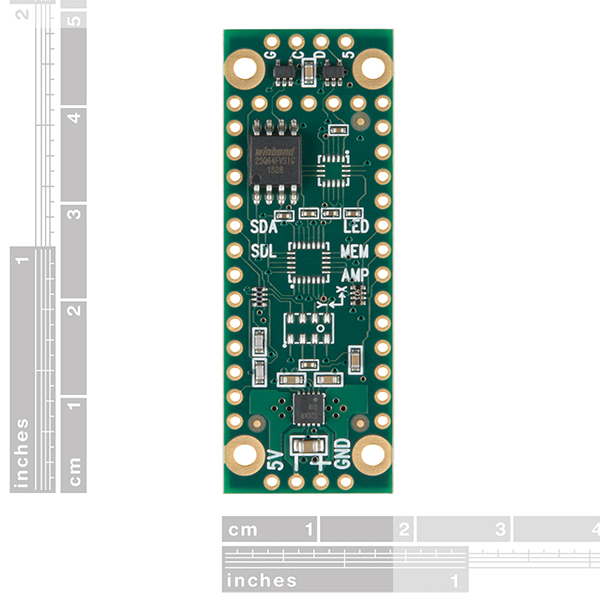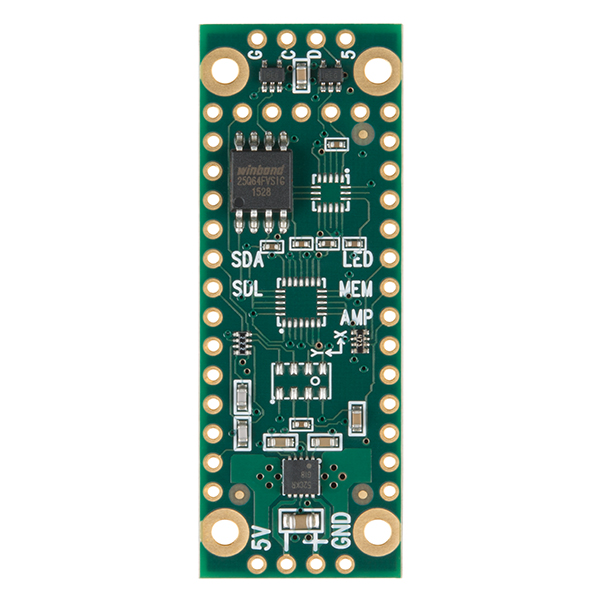Teensy Prop Shield LC
This low-cost (LC) Teensy Prop Shield is meant for making light and sound effects on small, handheld props and wearable costumes. This shield features a 2W audio amp, high-speed 5V buffers for driving APA102 LEDs, and an 8MB flash memory. This economical board is approximately the size of a Teensy, just slightly longer to allow space for mounting holes and connections for power, speaker and LEDs.
This lower-cost Prop Shield is identical to the standard Prop Shield, except the motion sensors are removed. Keep in mind that this shield can be used with the Teensy 3.2 and is not restricted to use only with other "LC" models.
The Teensy Prop Shield has been equipped with a slew of neat features. Need an amplifier? The Teensy Prop Shield has one rated at 2W and is capable of driving 4 or 8 Ohm speakers. Additionally the Prop Shield has 5V buffers meant to send data to Dotstar or APA102 type addressable LEDs. It also has an onboard 8MB flash memory, meant for storing sound clips and images, logging data and many other uses.
Attention: Due to supply constraints, orders may not be filled immediately; orders not allocated to immediately, will be placed on backorder and filled as inventory allows. If you are a business, distributor, or reseller, please contact sales to place your order: sales@sparkfun.com.
- Audio Amplifier -- Clear quality audio output to a small speaker
- Fast LED Driver -- Drive APA102 / Dotstar LEDs for colorful lighting with rapid response
- Flash Memory -- 8MB storage for images, sound clips and data logging
Teensy Prop Shield LC Product Help and Resources
Vox Imperium: Stormtrooper Voice Changer
October 25, 2016
Add some flair to your Imperial uniform by changing your voice using a Teensy 3.2 and Prop Shield.
Core Skill: Soldering
This skill defines how difficult the soldering is on a particular product. It might be a couple simple solder joints, or require special reflow tools.
Skill Level: Noob - Some basic soldering is required, but it is limited to a just a few pins, basic through-hole soldering, and couple (if any) polarized components. A basic soldering iron is all you should need.
See all skill levels
Core Skill: Programming
If a board needs code or communicates somehow, you're going to need to know how to program or interface with it. The programming skill is all about communication and code.
Skill Level: Rookie - You will need a better fundamental understand of what code is, and how it works. You will be using beginner-level software and development tools like Arduino. You will be dealing directly with code, but numerous examples and libraries are available. Sensors or shields will communicate with serial or TTL.
See all skill levels
Core Skill: Electrical Prototyping
If it requires power, you need to know how much, what all the pins do, and how to hook it up. You may need to reference datasheets, schematics, and know the ins and outs of electronics.
Skill Level: Rookie - You may be required to know a bit more about the component, such as orientation, or how to hook it up, in addition to power requirements. You will need to understand polarized components.
See all skill levels
Comments
Looking for answers to technical questions?
We welcome your comments and suggestions below. However, if you are looking for solutions to technical questions please see our Technical Assistance page.
Customer Reviews
No reviews yet.




